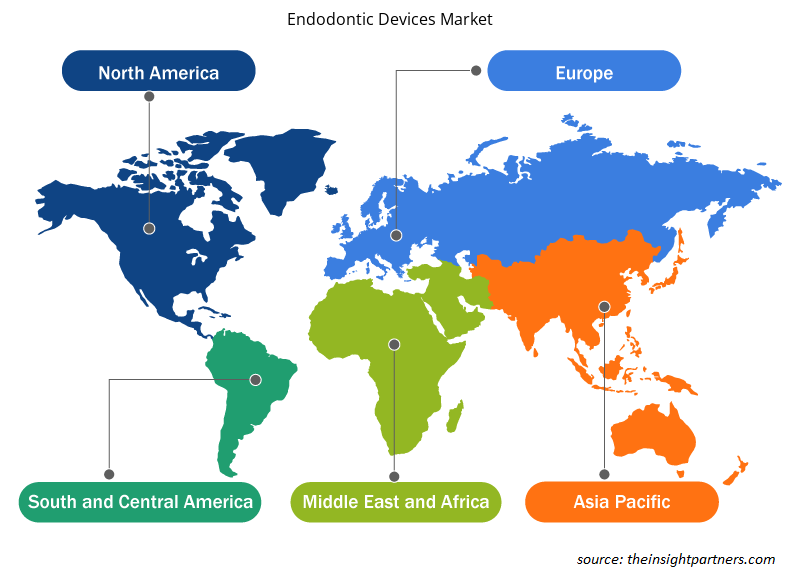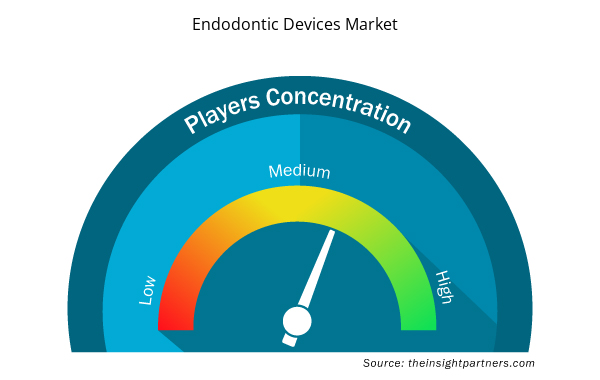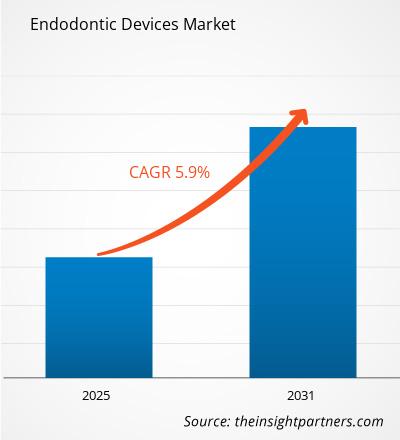Le marché des dispositifs endodontiques devrait enregistrer un TCAC de 5,9 % de 2023 à 2031, avec une taille de marché passant de XX millions USD en 2023 à XX millions USD d'ici 2031.
Le rapport est segmenté par produit (instruments et consommables endodontiques). Le rapport présente en outre une analyse basée sur l'utilisateur final (cliniques dentaires, hôpitaux dentaires et instituts universitaires et de recherche dentaires). L'analyse globale est ensuite décomposée au niveau régional et par principaux pays. Le rapport offre la valeur en USD pour l'analyse et les segments ci-dessus.
Objectif du rapport
Le rapport sur le marché des dispositifs endodontiques de The Insight Partners vise à décrire le paysage actuel et la croissance future, les principaux facteurs moteurs, les défis et les opportunités. Cela fournira des informations à diverses parties prenantes commerciales, telles que :
- Fournisseurs/fabricants de technologie : pour comprendre l’évolution de la dynamique du marché et connaître les opportunités de croissance potentielles, leur permettant de prendre des décisions stratégiques éclairées.
- Investisseurs : Effectuer une analyse complète des tendances concernant le taux de croissance du marché, les projections financières du marché et les opportunités qui existent tout au long de la chaîne de valeur.
- Organismes de réglementation : Réglementer les politiques et surveiller les activités du marché dans le but de minimiser les abus, de préserver la confiance des investisseurs et de maintenir l’intégrité et la stabilité du marché.
Segmentation du marché des dispositifs endodontiques
Produit
- Instruments et consommables endodontiques
Utilisateur final
- Cliniques dentaires
- Hôpitaux dentaires
- Instituts universitaires et de recherche dentaire
Personnalisez ce rapport en fonction de vos besoins
Vous bénéficierez d'une personnalisation gratuite de n'importe quel rapport, y compris de certaines parties de ce rapport, d'une analyse au niveau des pays, d'un pack de données Excel, ainsi que de superbes offres et réductions pour les start-ups et les universités.
- Obtenez les principales tendances clés du marché de ce rapport.Cet échantillon GRATUIT comprendra une analyse de données, allant des tendances du marché aux estimations et prévisions.
Facteurs de croissance du marché des dispositifs endodontiques
- Augmentation des problèmes dentaires : L'augmentation des cas de problèmes dentaires, tels que les caries et les infections pulpaires, accroît encore la demande en dispositifs endodontiques. Le développement de la carie dentaire à un âge avancé et la sensibilisation croissante aux soins bucco-dentaires stimulent les traitements du canal radiculaire dans plusieurs régions et contribuent ainsi au marché des solutions endodontiques.
- Progrès technologiques : les progrès réalisés dans le domaine des instruments endodontiques tels que les instruments rotatifs, les localisateurs d'apex et l'imagerie avancée améliorent la précision et l'efficacité du traitement des canaux radiculaires. Comme ces instruments permettent de réduire le temps nécessaire pour traiter les patients et d'obtenir de meilleurs résultats, davantage de praticiens les utiliseront, ce qui favorisera l'augmentation du marché des dispositifs endodontiques.
- Vieillissement de la population : le vieillissement de la population mondiale contribue à l'importance du marché des dispositifs endodontiques, car plus la population est âgée, plus elle est exposée aux caries dentaires et aux maladies parodontales. À mesure que l'espérance de vie augmente, la demande de soins dentaires, tels que les traitements du canal radiculaire, augmente également, ce qui entraîne un développement accru de produits sur le marché des dispositifs endodontiques, en particulier dans les pays développés.
Tendances futures du marché des dispositifs endodontiques
- Endodontie mini-invasive : La tendance est davantage aux traitements endodontiques mini-invasifs, utilisant des appareils et des approches avancés pour préserver la structure dentaire. Les traitements moins traumatisants sont également attrayants pour le patient et le praticien ; il est donc logique que la conception des outils endodontiques améliore la précision et l'efficacité.
- Intégration des technologies numériques : cela est dû à l'acceptation rapide des technologies numériques, comme l'imagerie 3D et les systèmes CFAO qui offrent une base solide pour le diagnostic, la planification appropriée du traitement et le résultat prédictif. L'application de ces technologies a amélioré le taux de réussite des procédures dans le domaine de l'endodontie, contribuant à une augmentation de la demande d'appareils compatibles avec le numérique.
- Traitements endodontiques en une seule visite : Dans le but de créer des soins plus accessibles et de réduire le nombre de rendez-vous, le besoin de traitements endodontiques le jour même est accru. Le résultat lui-même, par exemple les limes rotatives à grande vitesse, fait partie de la contribution que la technologie avancée apporte aux équipements endodontiques, et les meilleures techniques utilisées pour les obtenir permettent de réaliser les procédures dans des délais plus courts.
Opportunités de marché pour les dispositifs endodontiques
- Nouveaux marchés : les infrastructures de soins de santé en pleine croissance dans les marchés émergents d’Inde, de Chine et du Brésil offrent également des opportunités. À mesure que la sensibilisation aux soins dentaires s’accroît et que les traitements modernes deviennent plus accessibles, les fabricants cherchent à pénétrer ces régions avec des dispositifs endodontiques efficaces à des prix abordables. Cette croissance est stimulée par une combinaison de facteurs tels que l’augmentation des revenus disponibles, les initiatives gouvernementales en matière de soins de santé, les avancées technologiques et l’accent croissant mis sur les soins de santé préventifs.
- Progrès dans le domaine des biomatériaux : Le développement de nouveaux biomatériaux endodontiques, qui comprennent des scellants canalaires bioactifs et des traitements pulpaires régénératifs, présente une formidable opportunité. Ces matériaux peuvent potentiellement améliorer la cicatrisation et les résultats des traitements canalaires en réponse aux besoins des patients en matière de solutions dentaires plus efficaces et plus durables, contribuant ainsi à la croissance du marché.
- Tourisme dentaire : Le tourisme dentaire se développe dans les pays qui proposent des soins dentaires bon marché mais de qualité. Cette tendance ouvre de nouvelles perspectives au marché des dispositifs endodontiques, car les patients des pays développés recherchent des traitements moins coûteux à l'extérieur du pays. Les cabinets dentaires de ces régions sont susceptibles d'accroître leurs investissements dans des outils et équipements endodontiques de pointe pour attirer des clients internationaux.
Aperçu régional du marché des dispositifs endodontiques
Les tendances et facteurs régionaux influençant le marché des dispositifs endodontiques tout au long de la période de prévision ont été expliqués en détail par les analystes d’Insight Partners. Cette section traite également des segments et de la géographie du marché des dispositifs endodontiques en Amérique du Nord, en Europe, en Asie-Pacifique, au Moyen-Orient et en Afrique, ainsi qu’en Amérique du Sud et en Amérique centrale.

- Obtenez les données régionales spécifiques au marché des dispositifs endodontiques
Portée du rapport sur le marché des dispositifs endodontiques
| Attribut de rapport | Détails |
|---|---|
| Taille du marché en 2023 | XX millions de dollars américains |
| Taille du marché d'ici 2031 | XX millions de dollars américains |
| Taux de croissance annuel composé mondial (2023-2031) | 5,9% |
| Données historiques | 2021-2022 |
| Période de prévision | 2024-2031 |
| Segments couverts | Par produit
|
| Régions et pays couverts | Amérique du Nord
|
| Leaders du marché et profils d'entreprises clés |
|
Densité des acteurs du marché des dispositifs endodontiques : comprendre son impact sur la dynamique commerciale
Le marché des dispositifs endodontiques connaît une croissance rapide, tirée par la demande croissante des utilisateurs finaux en raison de facteurs tels que l'évolution des préférences des consommateurs, les avancées technologiques et une plus grande sensibilisation aux avantages du produit. À mesure que la demande augmente, les entreprises élargissent leurs offres, innovent pour répondre aux besoins des consommateurs et capitalisent sur les tendances émergentes, ce qui alimente davantage la croissance du marché.
La densité des acteurs du marché fait référence à la répartition des entreprises ou des sociétés opérant sur un marché ou un secteur particulier. Elle indique le nombre de concurrents (acteurs du marché) présents sur un marché donné par rapport à sa taille ou à sa valeur marchande totale.
Les principales entreprises opérant sur le marché des dispositifs endodontiques sont :
- Danaher
- Dentsply Sirona
- Ivoclar Vivadent AG
- Produits Ultradent Inc.
- Septodont Holding
Avis de non-responsabilité : les sociétés répertoriées ci-dessus ne sont pas classées dans un ordre particulier.

- Obtenez un aperçu des principaux acteurs du marché des dispositifs endodontiques
Principaux arguments de vente
- Couverture complète : Le rapport couvre de manière exhaustive l’analyse des produits, des services, des types et des utilisateurs finaux du marché des dispositifs endodontiques, offrant un paysage holistique.
- Analyse d’experts : Le rapport est compilé sur la base d’une compréhension approfondie des experts et analystes du secteur.
- Informations à jour : Le rapport garantit la pertinence commerciale en raison de sa couverture des informations récentes et des tendances des données.
- Options de personnalisation : ce rapport peut être personnalisé pour répondre aux exigences spécifiques du client et s'adapter parfaitement aux stratégies commerciales.
Le rapport de recherche sur le marché des dispositifs endodontiques peut donc aider à ouvrir la voie au décodage et à la compréhension du scénario de l’industrie et des perspectives de croissance. Bien qu’il puisse y avoir quelques préoccupations valables, les avantages globaux de ce rapport ont tendance à l’emporter sur les inconvénients.
- Analyse historique (2 ans), année de base, prévision (7 ans) avec TCAC
- Analyse PEST et SWO
- Taille du marché Valeur / Volume - Mondial, Régional, Pays
- Industrie et paysage concurrentiel
- Ensemble de données Excel



Report Coverage
Revenue forecast, Company Analysis, Industry landscape, Growth factors, and Trends

Segment Covered
This text is related
to segments covered.

Regional Scope
North America, Europe, Asia Pacific, Middle East & Africa, South & Central America

Country Scope
This text is related
to country scope.
Questions fréquemment posées
The endodontic devices market is estimated to grow with a CAGR of 5.9% from 2023 to 2031.
Asia-Pacific region is likely to witness the fastest growth rate during the forecast period.
The market drivers include the increasing prevalence of dental disorders, technological development in dentistry and rising geriatric population are driving the endodontic devices market
The endodontic devices market majorly consists of players such Danaher, Dentsply Sirona , Ivoclar Vivadent AG among others
Increasing adoption of AI in endodontic treatment planning is likely to remain the key trend during the forecast period.
North America dominated the endodontic devices market in 2023
Trends and growth analysis reports related to Life Sciences : READ MORE..
The List of Companies
- Danaher
- Dentsply Sirona
- Ivoclar Vivadent AG
- Ultradent Products Inc.
- Septodont Holding
- COLTENE Group
- FKG Dentaire SA
- Brasseler USA
- MANI,INC.
- Nikinc Dental
The Insight Partners performs research in 4 major stages: Data Collection & Secondary Research, Primary Research, Data Analysis and Data Triangulation & Final Review.
- Data Collection and Secondary Research:
As a market research and consulting firm operating from a decade, we have published and advised several client across the globe. First step for any study will start with an assessment of currently available data and insights from existing reports. Further, historical and current market information is collected from Investor Presentations, Annual Reports, SEC Filings, etc., and other information related to company’s performance and market positioning are gathered from Paid Databases (Factiva, Hoovers, and Reuters) and various other publications available in public domain.
Several associations trade associates, technical forums, institutes, societies and organization are accessed to gain technical as well as market related insights through their publications such as research papers, blogs and press releases related to the studies are referred to get cues about the market. Further, white papers, journals, magazines, and other news articles published in last 3 years are scrutinized and analyzed to understand the current market trends.
- Primary Research:
The primarily interview analysis comprise of data obtained from industry participants interview and answers to survey questions gathered by in-house primary team.
For primary research, interviews are conducted with industry experts/CEOs/Marketing Managers/VPs/Subject Matter Experts from both demand and supply side to get a 360-degree view of the market. The primary team conducts several interviews based on the complexity of the markets to understand the various market trends and dynamics which makes research more credible and precise.
A typical research interview fulfils the following functions:
- Provides first-hand information on the market size, market trends, growth trends, competitive landscape, and outlook
- Validates and strengthens in-house secondary research findings
- Develops the analysis team’s expertise and market understanding
Primary research involves email interactions and telephone interviews for each market, category, segment, and sub-segment across geographies. The participants who typically take part in such a process include, but are not limited to:
- Industry participants: VPs, business development managers, market intelligence managers and national sales managers
- Outside experts: Valuation experts, research analysts and key opinion leaders specializing in the electronics and semiconductor industry.
Below is the breakup of our primary respondents by company, designation, and region:

Once we receive the confirmation from primary research sources or primary respondents, we finalize the base year market estimation and forecast the data as per the macroeconomic and microeconomic factors assessed during data collection.
- Data Analysis:
Once data is validated through both secondary as well as primary respondents, we finalize the market estimations by hypothesis formulation and factor analysis at regional and country level.
- Macro-Economic Factor Analysis:
We analyse macroeconomic indicators such the gross domestic product (GDP), increase in the demand for goods and services across industries, technological advancement, regional economic growth, governmental policies, the influence of COVID-19, PEST analysis, and other aspects. This analysis aids in setting benchmarks for various nations/regions and approximating market splits. Additionally, the general trend of the aforementioned components aid in determining the market's development possibilities.
- Country Level Data:
Various factors that are especially aligned to the country are taken into account to determine the market size for a certain area and country, including the presence of vendors, such as headquarters and offices, the country's GDP, demand patterns, and industry growth. To comprehend the market dynamics for the nation, a number of growth variables, inhibitors, application areas, and current market trends are researched. The aforementioned elements aid in determining the country's overall market's growth potential.
- Company Profile:
The “Table of Contents” is formulated by listing and analyzing more than 25 - 30 companies operating in the market ecosystem across geographies. However, we profile only 10 companies as a standard practice in our syndicate reports. These 10 companies comprise leading, emerging, and regional players. Nonetheless, our analysis is not restricted to the 10 listed companies, we also analyze other companies present in the market to develop a holistic view and understand the prevailing trends. The “Company Profiles” section in the report covers key facts, business description, products & services, financial information, SWOT analysis, and key developments. The financial information presented is extracted from the annual reports and official documents of the publicly listed companies. Upon collecting the information for the sections of respective companies, we verify them via various primary sources and then compile the data in respective company profiles. The company level information helps us in deriving the base number as well as in forecasting the market size.
- Developing Base Number:
Aggregation of sales statistics (2020-2022) and macro-economic factor, and other secondary and primary research insights are utilized to arrive at base number and related market shares for 2022. The data gaps are identified in this step and relevant market data is analyzed, collected from paid primary interviews or databases. On finalizing the base year market size, forecasts are developed on the basis of macro-economic, industry and market growth factors and company level analysis.
- Data Triangulation and Final Review:
The market findings and base year market size calculations are validated from supply as well as demand side. Demand side validations are based on macro-economic factor analysis and benchmarks for respective regions and countries. In case of supply side validations, revenues of major companies are estimated (in case not available) based on industry benchmark, approximate number of employees, product portfolio, and primary interviews revenues are gathered. Further revenue from target product/service segment is assessed to avoid overshooting of market statistics. In case of heavy deviations between supply and demand side values, all thes steps are repeated to achieve synchronization.
We follow an iterative model, wherein we share our research findings with Subject Matter Experts (SME’s) and Key Opinion Leaders (KOLs) until consensus view of the market is not formulated – this model negates any drastic deviation in the opinions of experts. Only validated and universally acceptable research findings are quoted in our reports.
We have important check points that we use to validate our research findings – which we call – data triangulation, where we validate the information, we generate from secondary sources with primary interviews and then we re-validate with our internal data bases and Subject matter experts. This comprehensive model enables us to deliver high quality, reliable data in shortest possible time.


 Obtenez un échantillon gratuit pour ce rapport
Obtenez un échantillon gratuit pour ce rapport